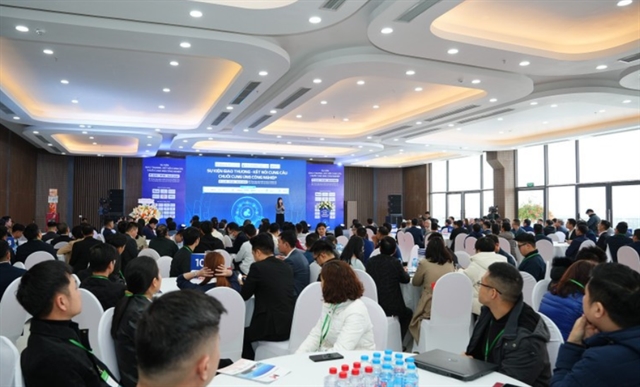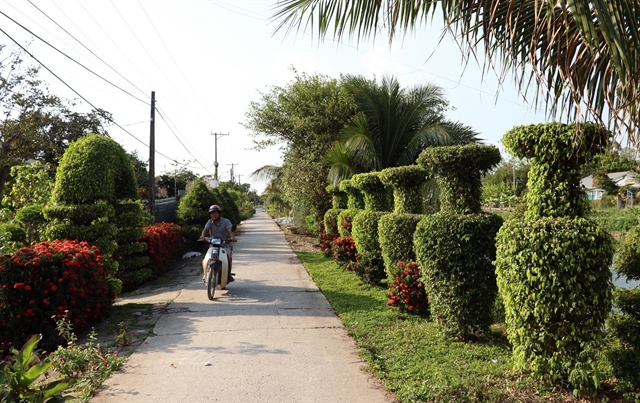 Society
Society

The Cửu Long (Mekong) Delta’s 12 provinces and Cần Thơ City have achieved good results in the national target programme on new - style rural area building, with rural incomes and living conditions improving considerably.

|
| Võ Văn Chiến, a 70 year - old farmer in Hồng Ngự Town’s Bình Thạnh Commune, said thanks to the programme, the town has got a good road network linking hamlets and communes and an excellent irrigation system. |
HCM CITY — The Cửu Long (Mekong) Delta’s 12 provinces and Cần Thơ City have achieved good results in the national target programme on new-style rural area building, with rural incomes and living conditions improving considerably.
The programme, launched by the Government in 2010, sets out 19 criteria for building new-style rural areas such as planning, transportation, electricity, irrigation, healthcare, culture, education, environment and social order.
In Đồng Tháp Province, 55 of 119 communes have achieved all 19 criteria, according to the local steering committee for the programme.
Nearly 100 per cent of people in these communes have access to electricity and the rate of schools meeting national standards is 75-100 per cent.
Võ Văn Chiến, a 70 year - old farmer in Hồng Ngự Town’s Bình Thạnh Commune, said thanks to the programme, the town has got a good road network linking hamlets and communes and an excellent irrigation system.
The province has undertaken many projects and measures for economic development and helped farmers apply them to agricultural production, he said.
Chiến’s family breeds mud carps and bighead carps during the flood season under a province project to improve flood drainage, develop livelihoods and adapt to climate change in the Đồng Tháp Mười (Plain of Reed) region.
In Sóc Trăng Province, Thạnh Qưới last month became the last commune in Mỹ Xuyên District to achieve all 19 criteria.
The district’s average per capita income has increased to VNĐ42.5 million (US$1830), 3.5 times the 2011 figure.
Đào Đắc Hùng, vice chairman of the Mỹ Xuyên District's People’s Committee, said rural areas have improved significantly, especially in planning, production and agriculture restructuring.
“Rural areas have extensive and modern infrastructure.”
Hundreds of households in the district have together donated more than 500,000sq.m of land for building infrastructure, he said.
The delta’s 12 provinces and Cần Thơ City have mobilised capital from public and private sources for the new-style rural area programme.
Vĩnh Long Province mobilised VNĐ7.13 trillion ($306.4 million), including VNĐ1.3 trillion from communities, companies and organisations in 2011-19.
Challenges persist
But despite all this, many challenges remain, including gaps in infrastructure and the impacts of climate change, according to the central steering office of the national programme.
The ratio of delta communes that meet all 19 criteria is 40.6 per cent while the national average is 48.7 per cent.
The impacts of climate change cause saltwater intrusion, soil erosion, subsidence and flooding, affecting people’s lives and production.
The delta is the country’s largest rice, fruit and seafood producer.
New models
The delta has developed many farming models to adapt to climate change and improve production efficiency.
They include farmer's clubhouses in Đồng Tháp and the polyculture of raising rice, vegetables and animals on coastal sand dunes and in brackish water in Sóc Trăng, Trà Vinh and Bến Tre provinces.
Under the farmer clubhouse model in Đồng Tháp, established in 2016, farmers who grow the same crop participate voluntarily in a group known as a farmer’s clubhouse to compare notes.
Nguyễn Thanh Hùng, vice chairman of the Đồng Tháp Province's People’s Committee, said the province has 80 farmer’s clubhouses with more than 4,000 members.
This model has helped promote economic development and self-management in the community, he added.
Trà Vinh Province has developed a model of planting mangrove forests in coastal areas and breeding aquatic species in the forests to provide farmers with an extra income.
The delta has been implementing the Government’s One Commune-One Product programme since 2018 to develop strong agricultural and non-agricultural products and services.
Đồng Tháp has chosen flour products in Sa Đéc City and Châu Thành District, lotus-related products in Tháp Mười District, pink mandarin in Lai Vung District, and dried snakehead fish in Hồng Ngự Town and Tam Nông District under the programme.
It targets at least 50 per cent of its 61 traditional products - mostly food and beverages, garments, souvenirs, household items, and rural tourism products - meeting the programme’s standards by next year.
An Giang Province has chosen 10 products like herbal medicines, food and beverages, and tourism to achieve three-star standards under the programme.
Trương Kiến Thọ, deputy director of the province Department of Agriculture and Rural Development, said the programme is suitable and necessary for building new-style rural areas and restructuring agriculture.
It would help the province boost the process of building new-style rural areas, he said.
The province plans to focus on promoting the selected products through various channels, including online. — VNS




